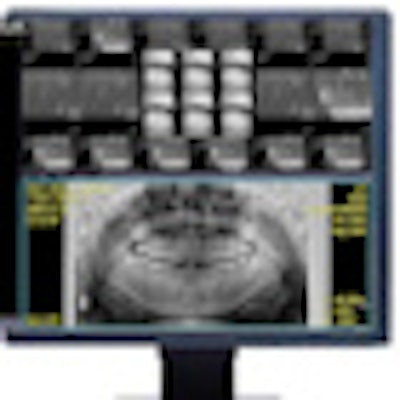
Case Western Reserve University (CWRU) School of Dental Medicine is making a long-term commitment to digital technologies with the implementation of an enterprise-wide dental picturing archiving and communications system (PACS) for use in dental research, patient care, and student training.
The dental PACS, developed and installed by Infinitt North America, is a Web-based image management system that allows health professionals to acquire, transmit, display, store, and share digital dental images and patient information electronically.
 The Infinitt Dental PACS supports cone-beam CT and all other dental imaging modalities, including panoramic, cephalometric, and intraoral sensors, and provides "always online" storage and multilevel backup. Image courtesy of Infinitt North America.
The Infinitt Dental PACS supports cone-beam CT and all other dental imaging modalities, including panoramic, cephalometric, and intraoral sensors, and provides "always online" storage and multilevel backup. Image courtesy of Infinitt North America.
The project has been in the works for the better part of a year, according to Sorin Teich, DMD, MBA, an associate professor and the director of clinical operations at the CWRU School of Dental Medicine.
"We want to go digital, and we are in the process of getting the entire school digital," he said. "This is one of the first steps. When we took such a drastic step, we wanted to have easy access to dental x-rays from all parts of the school for all users. We analyzed the pros and cons of having a centralized PACS versus other types of systems, and we decided this would be most beneficial to the school."
The School of Dental Medicine was established in 1892 and now includes specialty training programs in endodontics, periodontics, orthodontics, pediatrics, and oral and maxillofacial surgeries. In addition to its academic mission, CWRU provides dental health services for more than 70,000 patient visits a year.
After looking at other dental PACS, CWRU selected Infinitt's PACS because of its Web-based architecture and because Infinitt was willing to customize the system to support the school's integration requirements, according to Dr. Teich. CWRU chose to implement the system across all departments at once rather than incrementally so they could be completely electronic, have access to images from anywhere, and retrieve older images easily for comparison, he noted.
"The challenge was to integrate hardware and software from various suppliers," Dr. Teich said. "There are two major hardware suppliers, plus our EHR [electronic health record] vendor, and the PACS vendor, and our internal systems. It is very seamless now for the end user, but the process of all of this integration was a challenge."
The installation occurred in three major phases. The first was defining what the school needed and customizing the system accordingly, Dr. Teich said. They then installed the system in one department and conducted a pilot to discover any bugs or missing capabilities. The third phase was to implement the system across the entire school.
|
More dental schools investing in PACS Case Western Reserve University is one of a growing number of dental schools choosing to "go digital" with the acquisition, storage, and sharing of patient images and records. Earlier this year, Infinitt Japan signed a contract with Suidobashi Hospital to implement a dental PACS with a target launch date of March 2012. Suidobashi Hospital, located on the former Tokyo Dental College campus, is one of three hospitals comprising Tokyo Dental College, along with Chiba Hospital and Ichikawa General Hospital. Suidobashi Hospital currently treats an average of 500 patients per day and coordinates treatment with dental clinics around the region. Medicor Imaging, which introduced its dental MiPACS in 2001, claims to have installations in more than 40 dental schools around the world, including Midwestern University, Southern Illinois University, the University of Kentucky, the University of Washington, Temple University, the University of Queensland, and Mahidol University in Thailand. EBM Technologies also offers a dental PACS, the Pangea Dental, a browser-based, DICOM-compliant PACS designed for dental schools, hospitals, public health settings, and large group practices. |
The system is now integrated with the school's EHR system and supports cone-beam CT and all other dental imaging modalities, including panoramic, cephalometric, and intraoral sensors. The DICOM-compliant system provides "always online" storage and real-time, multilevel backup and includes a full-mouth x-ray display mode that provides comparison with a panoramic image. It also conforms with ISO 3950 Tooth Code, an international standard for designating teeth, surfaces of the teeth, and areas of the oral cavity.
While there was initially a learning curve, students and faculty are appreciating the advantages the new system offers, Dr. Teich said -- including being able to access images from locations outside the school and more easily sharing them in a secure environment with referring doctors.
"A large percentage of our faculty did not use digital x-rays or a PACS before," he said. "But early on we got some feedback that allowed us to make modifications that made them more comfortable. I think the students were very pleased, but they had some feedback also. We understand that as we prepare our students for the next decade, we have to prepare them for all the modalities that are out there. And we chose to focus on the ones that will be most practical for them."



















